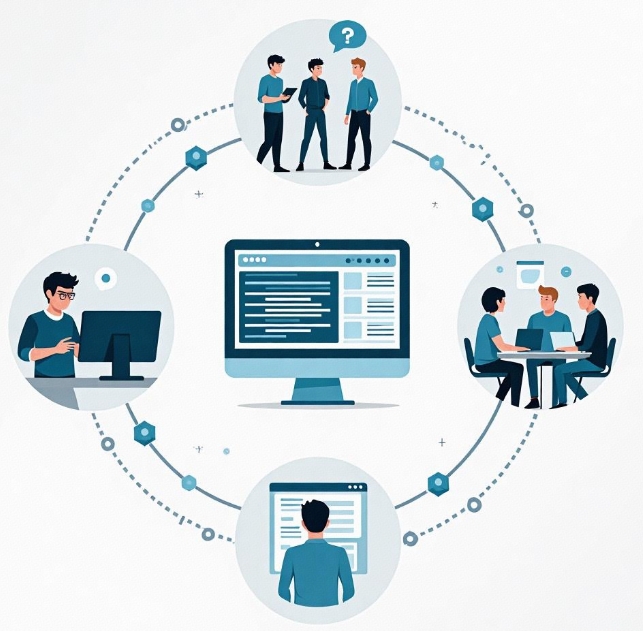How to Conduct Testing and Quality Control in Mall Development
- latest articles
- 1.DApp Development & Customization: Merging Diverse Market Needs with User Experience 2.Analysis of the Core Technical System in DApp Project Development 3.How to achieve cross-chain interoperability in Web3 projects? 4.How does the tokenization of points reconstruct the e-commerce ecosystem? 5.How to Set and Track Data Metrics for a Points Mall? 6.What is DApp Development? Core Concepts and Technical Analysis 7.Inventory of commonly used Web3 development tools and usage tips 8.Development of a Distribution System Integrated with Social E-commerce 9.Six Key Steps for Businesses to Build a Points Mall System 10.What is DApp Development? A Comprehensive Guide from Concept to Implementation
- Popular Articles
- 1.Future Trends and Technology Predictions for APP Development in 2025 2.Analysis of the DeFi Ecosystem: How Developers Can Participate in Decentralized Finance Innovation 3.From Zero to One: How PI Mall Revolutionizes the Traditional E-commerce Model 4.DAPP Development | Best Practices for Professional Customization and Rapid Launch 5.Recommended by the Web3 developer community: the most noteworthy forums and resources 6.From Cloud Computing to Computing Power Leasing: Building a Flexible and Scalable Computing Resource Platform 7.How to Develop a Successful Douyin Mini Program: Technical Architecture and Best Practices 8.Shared Bike System APP: The Convenient Choice in the Era of Smart Travel 9.How to Create a Successful Dating App: From Needs Analysis to User Experience Design 10.From Design to Development: The Complete Process of Bringing an APP Idea to Life
With the rapid development of the e-commerce industry, online stores have become one of the primary shopping methods for modern consumers. In the process of store development, besides focusing on feature implementation and user experience optimization, testing and quality control are also crucial aspects. The success of store development relies not only on exquisite design and comprehensive functionality but also on rigorous testing and quality control to ensure system stability, security, and scalability. This article will detail the testing and quality control processes in store development and propose corresponding optimization suggestions.
I. Overview of Testing and Quality Control in Store Development
In the process of store development, testing and quality control aim to identify and fix potential vulnerabilities, defects, and instabilities in the system, thereby ensuring its normal operation. This process covers the entire lifecycle from requirements analysis to design, development, and final deployment. High-quality testing can enhance the reliability, performance, and security of the store system, improving the user shopping experience.
The core goal of quality control is to ensure that various indicators of the software product meet predetermined standards, including but not limited to functional completeness, user experience optimization, security assurance, and performance stability. Testing, on the other hand, involves using different methods and tools during software development to simulate user operations and verify whether the system meets design requirements.
II. Main Content of Store Development Testing
The testing content of a store system can be divided based on different testing phases. Generally, store system testing can be categorized into the following main stages:
1. Functional Testing
Functional testing is the most fundamental and critical testing phase in store system development. Its purpose is to verify whether all store functions work as expected. For example, whether product browsing, adding to cart, order checkout, payment system, coupon functionality, membership management, etc., operate correctly.
Testing Focus: Whether product addition, deletion, modification, and query work normally, whether the shopping cart function correctly adds and removes items, whether the payment process is smooth and can handle multiple payment methods, etc.
Testing Methods: Can be conducted through manual testing and automated testing. Manual testing is suitable for complex functional modules, while automated testing can be used for highly repetitive and stable functions.
2. Performance Testing
As store business grows, system performance becomes an important issue that cannot be ignored. The main purpose of performance testing is to examine the store system's response speed, concurrent processing capability, and system stability under different load conditions.
Testing Focus: System response time, system load capacity during concurrent access, database query efficiency, etc.
Testing Methods: Common performance testing tools include LoadRunner, JMeter, etc. By simulating a large number of users accessing the store system simultaneously, test the system's performance under high concurrency.
3. Security Testing
Security is a critical aspect of store system development, especially when it involves user personal information and payment security. The store system needs to defend against various network attacks, such as SQL injection, XSS attacks, CSRF attacks, etc.
Testing Focus: User data protection, encrypted transmission of payment information, reasonableness of access control, etc.
Testing Methods: Use vulnerability scanning tools (such as OWASP ZAP, Burp Suite) to perform common vulnerability scans, ensuring the store system has good security protection capabilities.
4. Compatibility Testing
The store system needs to be compatible with various devices and browsers to ensure a consistent user experience whether users are on computers, mobile phones, or tablets. Therefore, compatibility testing is an indispensable part.
Testing Focus: Whether performance is consistent across different operating systems (Windows, macOS, Android, iOS) and browsers (Chrome, Firefox, Safari, etc.).
Testing Methods: Use tools like virtual machines or device cloud services to conduct cross-platform compatibility testing, ensuring the store interface adapts well on different devices and browsers.
5. User Experience Testing
User Experience Testing (UX Testing) evaluates the store system's usability, interaction design, interface aesthetics, and other aspects by simulating real user operations. A good user experience can enhance user satisfaction and loyalty.
Testing Focus: Page loading speed, whether the interface design is simple and clear, whether user flows are smooth, whether user feedback is timely, etc.
Testing Methods: Use methods such as user interviews, A/B testing, and usability testing to collect user feedback and optimize the store's design and functionality.
6. Regression Testing
The purpose of regression testing is to verify whether other parts of the system are affected after version updates or fixes in the store system, ensuring system stability and functional integrity. Store systems often undergo multiple updates during development, making regression testing particularly important.
Testing Focus: Whether the addition of new features affects the normal operation of existing functions.
Testing Methods: Conduct focused testing on modified or new features and perform comprehensive regression testing on existing functions.
III. Main Methods of Quality Control in Store Development
In the process of store development, quality control relies not only on testing but also on a series of methods to ensure the overall quality of the software.
1. Code Review and Static Analysis
Code review is an important quality control method in the software development process. By having team members review each other's code, potential issues can be identified early and optimized. Additionally, static analysis tools can scan the code for potential defects, such as non-compliance with coding standards, possible memory leaks, etc.
Recommended Tools: Static analysis tools like SonarQube, PMD, etc.
2. Continuous Integration and Automated Testing
Continuous Integration (CI) refers to frequently integrating developers' code into the main branch and using automated builds and tests to detect issues during integration. Through continuous integration, automated testing can be performed at each development stage to identify and fix problems promptly.
Recommended Tools: Jenkins, GitLab CI, Travis CI, etc.
3. Version Control and Branch Management
Version control is an indispensable part of the store development process. By using version control tools (such as Git), code versions can be effectively managed to avoid conflicts when multiple developers modify the same code simultaneously. Additionally, a reasonable branch management strategy ensures that feature development, bug fixes, and deployments proceed in an orderly manner.
Branch Strategy: Generally, branch management models like Git Flow or GitHub Flow are used to better organize and control various tasks during development.
4. Test-Driven Development (TDD)
Test-Driven Development is a development methodology that emphasizes writing test cases before writing the actual code. TDD not only improves code quality but also ensures that the system maintains high test coverage throughout the development process.
Recommended Tools: JUnit, TestNG, etc.
IV. Quality Control Process in Store Development
The quality control process in store development typically includes the following steps:
Requirements Analysis and Review: Conduct detailed requirements analysis at the project's initial stage and ensure the accuracy and completeness of requirements through requirements review.
Design and Development: Follow coding standards during system design and development, focus on code quality control, and conduct regular code reviews.
Testing and Feedback: Use various types of testing to identify issues and provide timely feedback and fixes based on test results.
Deployment and Monitoring: After the store system goes live, continue monitoring to ensure stable operation in actual use and promptly address any issues that arise.
V. Summary and Outlook
Testing and quality control in store development are the foundation for ensuring stable, efficient, and secure system operation. Through rigorous testing processes and effective quality control methods, system risks can be minimized, user experience enhanced, and the store's competitiveness strengthened. With technological advancements, future testing and quality control in store development will become more intelligent and automated. The application of new technologies such as artificial intelligence and big data will further improve testing efficiency and quality.
In actual development, teams should flexibly adjust testing and quality control strategies based on project requirements and actual conditions, continuously optimize the system, and enhance the overall quality and user satisfaction of the store.
-

How does the tokenization of points reconstruct the e-commerce ecosystem?
With the continuous advancement of internet technology and the gradual prolifera···
-

How to Set and Track Data Metrics for a Points Mall?
With the rapid development of the e-commerce industry, points malls, as a common···
-

Development of a Distribution System Integrated with Social E-commerce
With the rapid development of internet technology, the e-commerce industry has e···

 Blockchain
Blockchain












